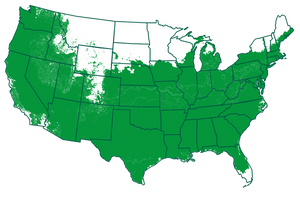* Images shown are of mature plants

Have questions? Talk with our Plant Experts (800) 973-8959
Tons of Large, Firm Berries Each Year
Ahhhh, the sweet flavor of black raspberries in the summer-time! What makes the Jewel Black Raspberry extra special is they grow larger than most, and have very few seeds. The plump berries are more firm than store-bought berries that tend to be soft by the time they make it to the produce section. You'll enjoy a large mid-season harvest year after year.
The Cumberland Black Raspberry Bush is cold hardy and will withstand subzero temperatures. It's low-maintenance, disease-resistant and can grow almost anywhere and in all types of soil. It's not a fussy plant and will thrive once planted in the ground. It will arrive at your door with its full root system intact. This speeds up the process, as the bush doesn't have to start over establishing a healthy root system. Expect this bush to yield a large bounty early summer every year.
You don't need a large plot of land to grow the Jewel Black Raspberry bush. This fast-growing plant matures 4-5 feet high and is only 3-4 feet wide. Find a corner that receives full sun and has well-draining soil, and watch it take off. It's a great addition to your garden but will grow just as strong on its own. It will do best in Zones 5-9.
Pollination Info
Jewel Black Raspberry Pollination
Jewel Black Raspberrys are self-fertile. You will get fruit with only one plant. However, adding an additional Jewel Black Raspberry will drastically increase the size of your crop.
Planting & Care
The Jewel Black Raspberry is good for USDA growing zones 5-9, making it a hardy plant with the ability to make it through cold winters. They are fast growing, small plants with mature heights of 4-5 feet, widths of 3-4 feet and packed with big flavors! Their medium-large, blue-black berries are loaded with vitamins, minerals, antioxidants, fiber and contain very few seeds. Once picked, eat them quickly or store in the refrigerator as their shelf life is short. Enjoy them in a pie, as a syrup, jelly or fresh off the vine!
Location: Choose a location that offers full sun and gives the Raspberries good air circulation. Areas that encounter high winds can pose a threat to the canes and should be avoided. Also, be sure there are no wild blackberries growing nearby which could spread diseases that can prove harmful to your plant. The soil should be nutrient dense and well-draining.
Planting Instructions:
1) If possible, plant your Raspberries early in the spring. If you live in a warmer area of the country plant in late winter.
2) A week before you plant, prepare the soil with compost or aged manure.
3) Soak the roots for an hour or two before planting to ensure proper moisture.
4) Dig a hole that provides enough room for the roots to spread out.
5) For multiple plants, space Raspberries about 3 feet apart, in rows 8 feet apart.
6)A trellis or a fence can provide extra support for growth. If you chose to use this option, do it from the beginning of planting so the plants are not disturbed when maturing.
Watering: Water your Raspberry plant at a rate of 1 inch of water per week. Increase water as necessary during dry periods but do not over water.
Pruning: Prune Raspberries in the fall, leaving about 6 of the thickest, strongest green canes. Make sure you cut off any sideways growing canes.
Fertilizer: You can use compost with a small amount of balanced organic fertilizer, applying late in the winter. It’s also a good idea to spread mulch in the planting area to maintain moisture and discourage weed growth.
Pests: Raspberries are not prone to many diseases but are susceptible to powdery mildew. The fungus can rob Raspberries of vital nutrients and weaken the plant. The disease looks like a dusting of flour and usually starts off in circular white spots. If left untreated, the plant’s leaves will begin to yellow and dry out. To treat, remove all infected leaves/fruit and make sure never to use these parts as compost. Use a fungicide which contains sulfur, neem oil or potassium bicarbonate.
Tips:
*If you don’t want to trellis your Raspberries, just let them grow in a slightly arched position so they have ample room as the fruit ripens.
*Prune away the shoots that grow up from the roots as well as old or damaged canes which will better enable the surviving canes to produce lots of berries.
Shipping Details
Estimated Shipping Time: Most orders ship immediately. As noted on the website, some items are seasonal, and may only ship in spring or fall. Once your order is shipped, you'll receive an email with a tracking number.
| Amount of Order | Shipping Charge |
|---|---|
| Less than $49 | $19.95 |
| $49 + | FREE SHIPPING! |
Product Details
| Mature Height: | 4-5 ft. |
| Mature Width: | 3-4 ft. |
| Sunlight: | Full Sun |
| Growth Rate: | Moderate Growing |
| Harvest Time: | June - July |
| Botanical Name: | Rubus idaeus 'Jewel' |
| Does Not Ship To: | AK, AZ, HI, OR, TX |
| Grows Well In Zones: | 5-9 outdoors |
| Your Growing Zone: | # |







